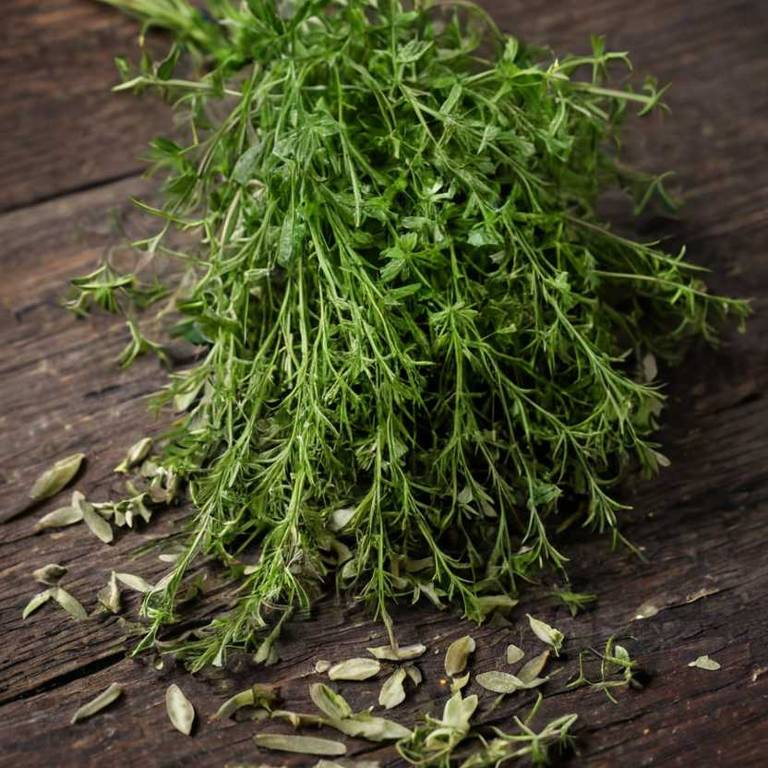By Leen Randell
Updated: Jul 20, 2024
10 Medicinal Constituents Of Corchorus Olitorius (Jute)

Corchorus olitorius has active constituents such as flavonoids, phenolic acids, and ascorbic acid.
These compounds exhibit antimicrobial, anti-inflammatory, and antioxidant properties. The medicinal properties of jute include wound healing, anti-diabetic, and cardiovascular health improvement.
For instance, flavonoids in jute may help alleviate symptoms of diabetes by reducing blood sugar levels and improving insulin sensitivity.
This article explains in details the 10 best active constituents of Corchorus olitorius.
1. Luteolin
Corchorus olitorius luteolin is a flavonoid compound extracted from the leaves of the plant.
It has been traditionally used in Asian medicine for centuries to treat various ailments, including fever, rheumatism, and respiratory issues. Luteolin exhibits antioxidant, anti-inflammatory, and antimicrobial properties, which may contribute to its potential health benefits, such as reducing oxidative stress and improving cardiovascular health.
Further research is needed to fully understand the therapeutic effects of luteolin from Corchorus olitorius.
2. Apigenin
Corchorus olitorius apigenin is a flavonoid compound present in its leaves.
Apigenin has been found to possess various biological activities, including antioxidant, anti-inflammatory, and antitumor properties. Studies have shown that it can inhibit the growth of cancer cells and induce apoptosis, making it a potential agent for the prevention and treatment of certain types of cancer.
Further research is needed to fully understand its effects on human health.
3. Quercetin
Corchorus olitorius quercetin is a flavonoid compound found in its leaves.
Quercetin has been shown to possess numerous biological activities, including anti-inflammatory, antioxidant, and antibacterial properties. It has been reported to exhibit potential therapeutic effects on various diseases, such as cardiovascular disorders, cancer, and respiratory infections.
Additionally, quercetin has also been found to have antimicrobial activity against several microorganisms, making it a promising compound for the development of novel medicines.
4. Kaempferol
Corchorus olitorius kaempferol is a flavonoid compound isolated from its leaves.
It exhibits significant antioxidant and free radical scavenging activities, which can help protect against oxidative stress-related diseases. Kaempferol has been reported to have anti-inflammatory and antibacterial properties, making it a potential therapeutic agent for various ailments.
Additionally, it may also possess antidiabetic and cardioprotective effects, highlighting its potential as a natural remedy for various health issues.
5. Gallic acid
Corchorus olitorius gallic acid is a phenolic compound derived from its leaves.
It has been shown to possess numerous bioactive properties, including antioxidant and anti-inflammatory activities. Gallic acid has been traditionally used in traditional medicine for various ailments, such as fever, cough, and respiratory issues.
Additionally, it has been found to exhibit antimicrobial and antiviral effects, making it a promising compound for the development of novel therapeutic agents.
6. Caffeic acid
Corchorus olitorius caffeic acid is a type of polyphenolic compound found in its leaves.
It has been reported to possess various biological activities, including antioxidant, anti-inflammatory, and antimicrobial properties.
Caffeic acid in Corchorus olitorius has been shown to exhibit potent inhibition against certain enzymes and has also been found to have potential therapeutic applications in the treatment of various diseases.
7. Ferulic acid
Corchorus olitorius ferulic acid is a type of polyphenolic compound extracted from its leaves.
It has been reported to possess numerous biological activities, including antioxidant, anti-inflammatory, and antimicrobial properties. Ferulic acid has also been shown to have potential therapeutic applications in the treatment of various diseases, such as cardiovascular disorders, cancer, and neurodegenerative diseases.
Its bioactive effects make it a valuable natural compound for pharmaceutical and food industries.
8. Oleanolic acid
Corchorus olitorius oleanolic acid is a type of triterpenoid saponin found in its leaves and stems.
It has been extensively studied for its potential biological activities, including antioxidant, anti-inflammatory, and anticancer properties.
Oleanolic acid has been shown to exhibit inhibitory effects on various enzymes, including lipoxygenase and cyclooxygenase, and has been used as a natural remedy for various diseases in traditional medicine.
9. Ursolic acid
Corchorus olitorius ursolic acid is a triterpenoid compound extracted from its leaves.
It has been extensively studied for its potential health benefits, including anti-inflammatory, antioxidant, and anticancer properties. Ursolic acid has been shown to inhibit the growth of various cancer cells and induce apoptosis (cell death) in some cases.
It also exhibits antimicrobial activity against certain bacteria and fungi, making it a promising compound for the development of new therapeutic agents.
10. Betulinic acid
Corchorus olitorius betulinic acid is a bioactive compound extracted from the leaves of the plant.
This acid has been found to possess various pharmacological activities, including antioxidant, anti-inflammatory, and antitumor properties. It has been shown to inhibit the growth of cancer cells, induce apoptosis (cell death), and protect against oxidative stress.
Its potential therapeutic applications are being explored in the treatment of diseases such as cancer, diabetes, and cardiovascular disorders.